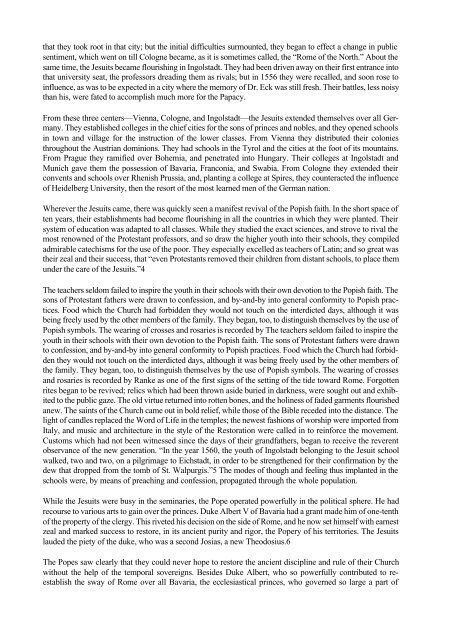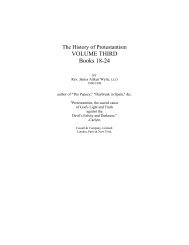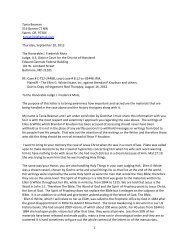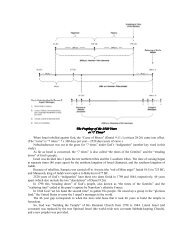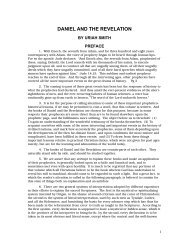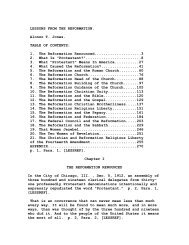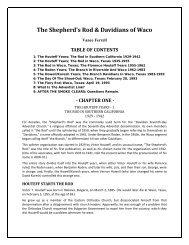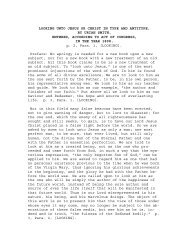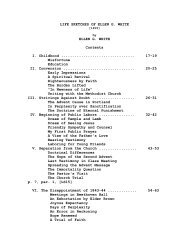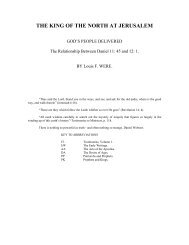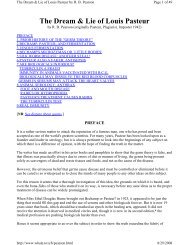History of Jesuits
History of Jesuits
History of Jesuits
You also want an ePaper? Increase the reach of your titles
YUMPU automatically turns print PDFs into web optimized ePapers that Google loves.
that they took root in that city; but the initial difficulties surmounted, they began to effect a change in public<br />
sentiment, which went on till Cologne became, as it is sometimes called, the “Rome <strong>of</strong> the North.” About the<br />
same time, the <strong>Jesuits</strong> became flourishing in Ingolstadt. They had been driven away on their first entrance into<br />
that university seat, the pr<strong>of</strong>essors dreading them as rivals; but in 1556 they were recalled, and soon rose to<br />
influence, as was to be expected in a city where the memory <strong>of</strong> Dr. Eck was still fresh. Their battles, less noisy<br />
than his, were fated to accomplish much more for the Papacy.<br />
From these three centers—Vienna, Cologne, and Ingolstadt—the <strong>Jesuits</strong> extended themselves over all Germany.<br />
They established colleges in the chief cities for the sons <strong>of</strong> princes and nobles, and they opened schools<br />
in town and village for the instruction <strong>of</strong> the lower classes. From Vienna they distributed their colonies<br />
throughout the Austrian dominions. They had schools in the Tyrol and the cities at the foot <strong>of</strong> its mountains.<br />
From Prague they ramified over Bohemia, and penetrated into Hungary. Their colleges at Ingolstadt and<br />
Munich gave them the possession <strong>of</strong> Bavaria, Franconia, and Swabia. From Cologne they extended their<br />
convents and schools over Rhenish Prussia, and, planting a college at Spires, they counteracted the influence<br />
<strong>of</strong> Heidelberg University, then the resort <strong>of</strong> the most learned men <strong>of</strong> the German nation.<br />
Wherever the <strong>Jesuits</strong> came, there was quickly seen a manifest revival <strong>of</strong> the Popish faith. In the short space <strong>of</strong><br />
ten years, their establishments had become flourishing in all the countries in which they were planted. Their<br />
system <strong>of</strong> education was adapted to all classes. While they studied the exact sciences, and strove to rival the<br />
most renowned <strong>of</strong> the Protestant pr<strong>of</strong>essors, and so draw the higher youth into their schools, they compiled<br />
admirable catechisms for the use <strong>of</strong> the poor. They especially excelled as teachers <strong>of</strong> Latin; and so great was<br />
their zeal and their success, that “even Protestants removed their children from distant schools, to place them<br />
under the care <strong>of</strong> the <strong>Jesuits</strong>.”4<br />
The teachers seldom failed to inspire the youth in their schools with their own devotion to the Popish faith. The<br />
sons <strong>of</strong> Protestant fathers were drawn to confession, and by-and-by into general conformity to Popish practices.<br />
Food which the Church had forbidden they would not touch on the interdicted days, although it was<br />
being freely used by the other members <strong>of</strong> the family. They began, too, to distinguish themselves by the use <strong>of</strong><br />
Popish symbols. The wearing <strong>of</strong> crosses and rosaries is recorded by The teachers seldom failed to inspire the<br />
youth in their schools with their own devotion to the Popish faith. The sons <strong>of</strong> Protestant fathers were drawn<br />
to confession, and by-and-by into general conformity to Popish practices. Food which the Church had forbidden<br />
they would not touch on the interdicted days, although it was being freely used by the other members <strong>of</strong><br />
the family. They began, too, to distinguish themselves by the use <strong>of</strong> Popish symbols. The wearing <strong>of</strong> crosses<br />
and rosaries is recorded by Ranke as one <strong>of</strong> the first signs <strong>of</strong> the setting <strong>of</strong> the tide toward Rome. Forgotten<br />
rites began to be revived; relics which had been thrown aside buried in darkness, were sought out and exhibited<br />
to the public gaze. The old virtue returned into rotten bones, and the holiness <strong>of</strong> faded garments flourished<br />
anew. The saints <strong>of</strong> the Church came out in bold relief, while those <strong>of</strong> the Bible receded into the distance. The<br />
light <strong>of</strong> candles replaced the Word <strong>of</strong> Life in the temples; the newest fashions <strong>of</strong> worship were imported from<br />
Italy, and music and architecture in the style <strong>of</strong> the Restoration were called in to reinforce the movement.<br />
Customs which had not been witnessed since the days <strong>of</strong> their grandfathers, began to receive the reverent<br />
observance <strong>of</strong> the new generation. “In the year 1560, the youth <strong>of</strong> Ingolstadt belonging to the Jesuit school<br />
walked, two and two, on a pilgrimage to Eichstadt, in order to be strengthened for their confirmation by the<br />
dew that dropped from the tomb <strong>of</strong> St. Walpurgis.”5 The modes <strong>of</strong> though and feeling thus implanted in the<br />
schools were, by means <strong>of</strong> preaching and confession, propagated through the whole population.<br />
While the <strong>Jesuits</strong> were busy in the seminaries, the Pope operated powerfully in the political sphere. He had<br />
recourse to various arts to gain over the princes. Duke Albert V <strong>of</strong> Bavaria had a grant made him <strong>of</strong> one-tenth<br />
<strong>of</strong> the property <strong>of</strong> the clergy. This riveted his decision on the side <strong>of</strong> Rome, and he now set himself with earnest<br />
zeal and marked success to restore, in its ancient purity and rigor, the Popery <strong>of</strong> his territories. The <strong>Jesuits</strong><br />
lauded the piety <strong>of</strong> the duke, who was a second Josias, a new Theodosius.6<br />
The Popes saw clearly that they could never hope to restore the ancient discipline and rule <strong>of</strong> their Church<br />
without the help <strong>of</strong> the temporal sovereigns. Besides Duke Albert, who so powerfully contributed to reestablish<br />
the sway <strong>of</strong> Rome over all Bavaria, the ecclesiastical princes, who governed so large a part <strong>of</strong>


